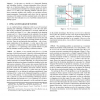101 search results - page 11 / 21 » Reviving Partial Order Planning |
AAAI
1996
13 years 8 months ago
1996
Partial-Order Causal Link planners typically take a "least-commitment" approach to some decisions (notably, step ordering), postponing those decisions until constraints ...
AAAI
2010
13 years 8 months ago
2010
Multi-Agent Plan Recognition (MAPR) seeks to identify the dynamic team structures and team behaviors from the observations of the activity-sequences of a set of intelligent agents...
ECAI
2004
Springer
14 years 3 days ago
2004
Springer
In this paper we describe IPSS (Integrated Planning and Scheduling System), a domain independent solver that integrates an AI heuristic planner, that synthesizes courses of actions...
FCS
2007
13 years 8 months ago
2007
In many task-planning domains, dynamic assemblies of autonomous agents are replacing hierarchical organisations because they promise more agility. In such assemblies, interdepende...
VIP
2000
13 years 8 months ago
2000
Series Parallel (SP) digraphs are a common method of representing instructions with partially ordered actions, but not always an ideal one, as relationships among groups of action...

